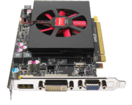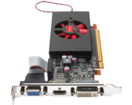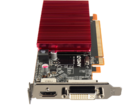Monday, February 7th 2011

AMD Outs Radeon HD 6670, HD 6570, HD 6450 for OEMs
AMD released the entire entry-mid portion of the Radeon HD 6000 series overnight, for OEMs only. The cards won't be available to consumers (retail) as yet, but does give away specifications of two new GPUs that AMD is carving these SKUs out of, Turks and Caicos. Built on the 40 nm process, Turks packs 480 VLIW5 stream processors, is DirectX 11 compliant, and sports a 128-bit wide GDDR5 memory controller that supports GDDR3 on lower SKUs. Radeon HD 6670 and HD 6570 are based on Turks. Both have all 480 stream processors enabled, differ in memory type/amount and clock speeds. The HD 6670 carries clock speeds of 800 MHz core, 1000 MHz (4.00 GHz GDDR5 effective) memory, and is available with memory amounts of 512 MB or 1 GB. The 128-bit wide memory interface churns out bandwidth of 64 GB/s.
The HD 6570 is also based on Turks, but features clock speeds of 650 MHz core, and two different memory clock speed specifications based on the memory type opted for by the manufacturers. If a manufacturer chooses GDDR3, it's clocked at 900 MHz (1.80 GHz GDDR3 effective), with a memory bandwidth of 28.8 GB/s. If it's GDDR5, it's clocked at 1000 MHz (4.00 GHz effective), 64 GB/s bandwidth. Up to 2 GB of memory can be opted for GDDR3 designs, while up to 1 GB can be opted for GDDR5-based ones. While the HD 6670 reference board uses a full-height design with a single-slot fan-heatsink, HD 6570 is designed for low-profile cards, best suited for HTPCs or SFF PCs.Lastly, there's the HD 6450, which is based on the Caicos silicon. This is AMD's entry-level GPU, which is geared to be an IGP replacement or for users who just need a GPU that does everything an IGP does, faster. Caicos is an improvement over previous-generation Cedar. It features 160 VLIW5 stream processors, twice that of Cedar. It features a leaner 64-bit memory controller that supports GDDR5 and DDR3. Partners are free to set GPU clock speeds in the range of 625 MHz to 750 MHz, while its memory can be clocked at 533 to 800 MHz for DDR3, or 800 to 900 MHz for GDDR5. It is designed for cards that are both low-profile, and silent (passively-cooled). There's no information on retail release, but we can't imagine them to be too far away.
The HD 6570 is also based on Turks, but features clock speeds of 650 MHz core, and two different memory clock speed specifications based on the memory type opted for by the manufacturers. If a manufacturer chooses GDDR3, it's clocked at 900 MHz (1.80 GHz GDDR3 effective), with a memory bandwidth of 28.8 GB/s. If it's GDDR5, it's clocked at 1000 MHz (4.00 GHz effective), 64 GB/s bandwidth. Up to 2 GB of memory can be opted for GDDR3 designs, while up to 1 GB can be opted for GDDR5-based ones. While the HD 6670 reference board uses a full-height design with a single-slot fan-heatsink, HD 6570 is designed for low-profile cards, best suited for HTPCs or SFF PCs.Lastly, there's the HD 6450, which is based on the Caicos silicon. This is AMD's entry-level GPU, which is geared to be an IGP replacement or for users who just need a GPU that does everything an IGP does, faster. Caicos is an improvement over previous-generation Cedar. It features 160 VLIW5 stream processors, twice that of Cedar. It features a leaner 64-bit memory controller that supports GDDR5 and DDR3. Partners are free to set GPU clock speeds in the range of 625 MHz to 750 MHz, while its memory can be clocked at 533 to 800 MHz for DDR3, or 800 to 900 MHz for GDDR5. It is designed for cards that are both low-profile, and silent (passively-cooled). There's no information on retail release, but we can't imagine them to be too far away.



55 Comments on AMD Outs Radeon HD 6670, HD 6570, HD 6450 for OEMs
HD 6600 Series and HD 6700 Series Is just change names with a little lie
HD 5570
400 Stream Processing Units
Engine clock speed: 650 MHz
Memory clock speed DDR3: 900 MHz
Memory bandwidth DDR3: 28.8 GB/s
1GB
HD 6570
480 Stream Processing Units
Engine clock speed: 650 MHz
Memory clock speed DDR3: 900 MHz
Memory bandwidth DDR3: 28.8 GB/s
2GB
2 GB :roll:
The 6670 and 6570 use the same new 480 sp turks core not the redwood core, or are you trying to say this whole time the redwood core had 80 locked sp's that no one knew about?
TheMailMan78
@
bear jesus
The truth Always bitter ;)
6000 uses at 4:1 shader thing.
where the old 5000 uses 5:1.
i love computers... everyones an expert... its like growing weed...
believe half of what you see and none of what you hear... :toast:
Thats funny Jiraya lol
If you never saw the thread about it most were complaining about the 57xx to 67xx re-branding as it is the same core with a different model name where as these cores are different cores.
How can it can be re-branding or renaming if its a new core, it can only really apply to the same core being given a new name like with the juniper core being renamed from 57xx to 67xx cards.
80 shaders
2 gb option
You could certainly argue it's not that different, but it's clearly not the same.
Seriously, stop feeding him. :banghead:
and to the vga i just hate old stuff heck i think hdmi is outdated and everything should be diplayport coming form me with old hardware lol:D
"Do not worry"
Jiraiya - out
LOL
you don't get more performance like that by just re-naming. And if you can... then i need to start calling my cpu a Core i7
Guys ignore pathetic people like this :)